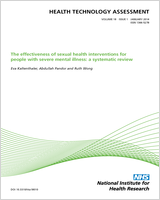Included under terms of UK Non-commercial Government License.
NCBI Bookshelf. A service of the National Library of Medicine, National Institutes of Health.
Hockenhull J, Elremeli M, Cherry MG, et al. A Systematic Review of the Clinical Effectiveness and Cost-Effectiveness of Pharmalgen® for the Treatment of Bee and Wasp Venom Allergy. Southampton (UK): NIHR Journals Library; 2012 Mar. (Health Technology Assessment, No. 16.12.)

A Systematic Review of the Clinical Effectiveness and Cost-Effectiveness of Pharmalgen® for the Treatment of Bee and Wasp Venom Allergy.
Show detailsTABLE 43Summary of the economic survey responses
| Questions | Response |
|---|---|
| Type of clinical unit | 14 from a unit in an acute hospital 1 from a unit in a community hospital 1 unit in a specialist hospital, no acute service |
| Type of individual receiving VIT in unit | 12 units provide VIT only to adults 2 units provide VIT only to children 2 units provide VIT to children and adults |
| No. of new venom-allergic individuals in a typical year | Wasp venom: 9.37 Bee venom: 3 Both wasp and bee venom: 0.87 Note that these are simple averages from 15 responses (one clinician did not fill in this question). No weighting was taken into account because we did not ask for the total number of individuals in each clinical unit. One provided a range of 5 to 10, and the median 7.5 was used for the average calculation |
| Age proportions of new individuals with severe systemic reaction to bee/wasp venom in a typical year | Under 20 years: 15% 20–39 years: 30% 40+ years: 54% These are simple averages without weighting |
| Treatment options prescribed to new patients with severe bee/wasp bee venom allergy | The majority of clinics provide VIT + HDA + AAI; four clinics provide VIT + AAI and 1 clinic uses VIT monotherapy only. For individuals not able to receive VIT, 10 clinics use HDA + AAI as an alternative treatment option. Very small numbers of clinics prescribe either HDA only or AAI only |
| Antihistamines prescribed (dosage) | Acrivastine (16 mg), acrivastine (8 mg), cetirizine (10–20 mg), fexofenadine (180 mg), piriton, loratadine (10–20 mg), chlorphenamine (8 mg) |
| VIT for individuals with both bee and wasp allergy | 5 clinics provide VIT for the more severe allergy 3 clinics provide VIT for both bee and wasp allergy |
| Advice given to people undergoing VIT should they experience re-sting | 3 clinics advise use of HDA followed by AAI (if systemic reaction occurs); also advise visit to A&E 4 clinics advise use of HDA and administration of AAI if individual has difficulty breathing or feels faint 1 clinic advises use of HDA + steroid + AAI if systemic reaction occurs 1 clinic advises HDA only 1 clinic advises removal of sting and use of HDA + AAI |
| Most common ARs during VIT | Local reactions (mainly swelling and itching) stated by all 15 clinics Other common ARs include urticaria and fatigue. Less common reactions include pain, wheezing, local redness, Arthus-type reaction, anxiety tachycardia, headache, anaphylaxis and reduction in peak expiratory flow rate |
- Economic survey results - A Systematic Review of the Clinical Effectiveness and ...Economic survey results - A Systematic Review of the Clinical Effectiveness and Cost-Effectiveness of Pharmalgen® for the Treatment of Bee and Wasp Venom Allergy
Your browsing activity is empty.
Activity recording is turned off.
See more...